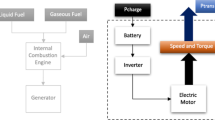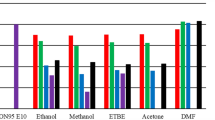Abstract
A preliminary analysis has been conducted to investigate the fuel use and emissions reduction potential of incorporating hybrid systems to two stroke powered tricycles in Metro Manila. Carbureted and direct injection two stroke engine hybrid systems were investigated and compared with the impact of shifting to four stroke engines. Results showed that hybridized direct injection retrofitted two stroke powered systems would be able to provide far better environmental and fuel reduction benefits than the shift to new four strokes tricycles. It is thus recommended that the development of such technology specifically for tricycles be seriously pursued.






Similar content being viewed by others
References
Aceves SM, Smith RJ (1998) A hybrid vehicle evaluation code and its application to vehicle design. In: Proceedings of the SAE international congress and exposition, Detroit, Feb. 27–Mar. 2
ADB (2005) Air and noise reduction from tricycles. Asian Development Bank, Manila
An F, Stodolsky F, Eberhardt J (1998) Fuel and emission impacts of heavy hybrid vehicles. In: Final Report ANL/ES/CP-98502, Argonne National Laboratory, USA
Biona JBM, Argamosa P (2006) Technology options for two stroke powered tricycles: laboratory test results. paper presented at the technology options for two stroke powered tricycles forum. One San Miguel Building, Ortigas Center, Philippines
Biona JBM, Culaba AB, Purvis MRI (2007) Energy use and emissions of two stroke powered tricycles in metro Manila. Transport Res Part D (in press, available on-line)
Chen J et al (2004) Motorcycle emissions and fuel consumption in Central Taiwan. Sci Total Environ 312:113–122
Conley J, Clark NN (2002) Optimal hybrid vehicle design using real world data to determine actual regenerative braking energy recovery. In: Proceeding of the total vehicle technology conference
Cuddy M, Wipke K (1997) Analysis of the fuel economy benefit of Drivetrain hybridization. SAE Technical Series Paper No. 970289. Society of Automotive Engineers, Warrendale
EPA (2005) Conversion factors for hydrocarbon emission components. Report No. EPA 420-R05–015. United States Environmental Protection Agency, Washington
Fernando B (2001) Resolution no. 02-36. Metro Manila Development Authority, Makati
Iwai N (1999) Analysis on fuel economy and advanced systems of hybrid vehicles. JSAE Rev 3–11
Johnson V, Wipke K, Rausen D (2000) HEV control strategy for real-time optimization of fuel economy and emissions. SAE Technical Series Paper No. 2000-0101543. Society of Automotive Engineers: Warrendale, PA
Mittal ML, Sharma C (2006) Emissions from vehicular transport in India. Anthropogenic emissions from energy activities in india: generation and source characterization Part 2. United States Agency for International Development, India
Rodriguez R (2004) San Fernando, La union wages successful campaign vs. 2-stroke, aging tricycles. CyberDyaryo Clean Air Journalism Project
Tan R, Culaba A, Purvis M (2004) POLCAGE 1.0-A possibilistic life-cycle assessment model for evaluating alternative transportation fuels. Environ Model Softw 19(10):907–918
Tzeng GH, Chen JJ (1998) Developing a Taipei motorcycle driving cycle for emissions and fuel economy. Transport Res Part D 3(1):19–27
Vyas AD, Ng HK, Santini D, Anderson JL (1997) Batteries and electric vehicles: evaluation of future characteristics and costs through Delphi method. In: Proceedings of the SAE international spring fuels and lubricants meeting. Detroit Michigan
Wang M (2001) Development of GREET 1.6 fuel cycle model for transportation fuels and vehicle technologies. Final Report ANL/ESD/TM-163, Argonne National Laboratory, USA
Willson B (2004) Direct injection as a retrofit strategy for reducing emissions from 2-stroke cycle engines in Asia. In: Proceedings of better air quality in Asian and Pacific Rim cities conference, Hong Kong
Author information
Authors and Affiliations
Corresponding author
Rights and permissions
About this article
Cite this article
Biona, J.B.M., Culaba, A.B. & Purvis, M.R.I. Fuel cycle analysis based evaluation of the fuel and emissions reduction potential of adapting the hybrid technology to tricycles. Clean Techn Environ Policy 10, 31–38 (2008). https://doi.org/10.1007/s10098-007-0124-5
Received:
Accepted:
Published:
Issue Date:
DOI: https://doi.org/10.1007/s10098-007-0124-5




